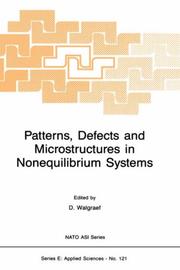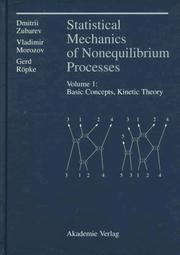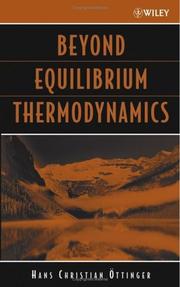Book
ISBN: 9781782620242 9781782622543 Year: 2016 Publisher: Cambridge, England : Royal Society of Chemistry,
Abstract | Keywords | Export | Availability | Bookmark
 Loading...
Loading...Choose an application
- Reference Manager
- EndNote
- RefWorks (Direct export to RefWorks)
Book
ISBN: 9810215711 Year: 1994 Publisher: Singapore World scientific
Abstract | Keywords | Export | Availability | Bookmark
 Loading...
Loading...Choose an application
- Reference Manager
- EndNote
- RefWorks (Direct export to RefWorks)
Nonequilibrium thermodynamics --- Statistical physics --- Stochastic processes
Book
ISBN: 1281934259 9786611934255 9812793372 9789812793379 9812793364 9789812793362 9781281934253 6611934251 Year: 2008 Publisher: Singapore ; Hackensack, NJ : World Scientific,
Abstract | Keywords | Export | Availability | Bookmark
 Loading...
Loading...Choose an application
- Reference Manager
- EndNote
- RefWorks (Direct export to RefWorks)
This volume presents the new objectives of physics on self-organising systems composed of multi-components, in order to create a new field and establish universal comprehension in physics.
Self-organizing systems --- Biophysics --- Nonequilibrium thermodynamics --- Astrophysics
Book
ISBN: 1316981363 1316983951 1139017845 Year: 2017 Publisher: Cambridge, England : Cambridge University Press,
Abstract | Keywords | Export | Availability | Bookmark
 Loading...
Loading...Choose an application
- Reference Manager
- EndNote
- RefWorks (Direct export to RefWorks)
Written by two specialists with over twenty-five years of experience in the field, this valuable text presents a wide range of topics within the growing field of nonequilibrium molecular dynamics (NEMD). It introduces theories which are fundamental to the field - namely, nonequilibrium statistical mechanics and nonequilibrium thermodynamics - and provides state-of-the-art algorithms and advice for designing reliable NEMD code, as well as examining applications for both atomic and molecular fluids. It discusses homogenous and inhomogenous flows and pays considerable attention to highly confined fluids, such as nanofluidics. In addition to statistical mechanics and thermodynamics, the book covers the themes of temperature and thermodynamic fluxes and their computation, the theory and algorithms for homogenous shear and elongational flows, response theory and its applications, heat and mass transport algorithms, applications in molecular rheology, highly confined fluids (nanofluidics), the phenomenon of slip and how to compute it from basic microscopic principles, and generalized hydrodynamics.

ISBN: 9024734797 9401080925 9400935595 Year: 1987 Publisher: Dordrecht Boston Lancaster Nijhoff
Abstract | Keywords | Export | Availability | Bookmark
 Loading...
Loading...Choose an application
- Reference Manager
- EndNote
- RefWorks (Direct export to RefWorks)
Materials --- Matter --- Microstructure --- Nonequilibrium thermodynamics --- Congresses. --- Constitution --- Congresses
Book
ISBN: 0387539964 3540539964 Year: 1991 Publisher: Berlin : Springer,
Abstract | Keywords | Export | Availability | Bookmark
 Loading...
Loading...Choose an application
- Reference Manager
- EndNote
- RefWorks (Direct export to RefWorks)
Nonequilibrium thermodynamics --- Polymers --- Rheology --- Statistical mechanics --- Mathematical models --- Congresses.

ISBN: 3055017080 3055017099 Year: 1996 Publisher: Berlin : Akademie Verlag,
Abstract | Keywords | Export | Availability | Bookmark
 Loading...
Loading...Choose an application
- Reference Manager
- EndNote
- RefWorks (Direct export to RefWorks)
Book
ISBN: 3110794047 9783110794045 Year: 2024 Publisher: Berlin : De Gruyter,
Abstract | Keywords | Export | Availability | Bookmark
 Loading...
Loading...Choose an application
- Reference Manager
- EndNote
- RefWorks (Direct export to RefWorks)
Transport and diffusion processes are central in numerous scientific and technical applications. Prominent examples are the temperature distribution in continuous media, the flow of liquids or gases, the dynamics of reaction-diffusion systems, or the concentration distributions in mixtures. The theoretical and numerical description of these systems is based on partial differential equations. The theory of non-equilibrium thermodynamics provides a frame to derive these equations from basic conservation laws and first principles. The first part of the textbook discusses the concept of equilibrium thermodynamics and its generalization to systems in local equilibrium. Thermodynamic fluxes are defined and caused by generalized forces. Finally, linear relations, the Onsager relations, between fluxes and forces allow for a closed description. In this way, conservation equations for mass (continuity), momentum (Euler or Navier-Stokes), and energy (temperature) are derived and solved analytically or numerically for several examples. The second part is based on the kinetic gas theory describing a classical many particle system. At the example of a perfect gas the conservation equations derived phenomenologically in the first part are thereby put on statistical grounds.
Book
ISBN: 9783031122217 Year: 2022 Publisher: Cham Springer International Publishing :Imprint: Springer
Abstract | Keywords | Export | Availability | Bookmark
 Loading...
Loading...Choose an application
- Reference Manager
- EndNote
- RefWorks (Direct export to RefWorks)

ISBN: 0471666580 9780471666585 9780471727910 0471727911 0471727903 9780471727903 Year: 2005 Publisher: Hoboken, N.J. : Wiley-Interscience,
Abstract | Keywords | Export | Availability | Bookmark
 Loading...
Loading...Choose an application
- Reference Manager
- EndNote
- RefWorks (Direct export to RefWorks)
Nonequilibrium thermodynamics --- Nonequilibrium thermodynamics. --- 536.7 --- 536.7 Thermodynamics. Energetics --- Thermodynamics. Energetics --- Irreversible thermodynamics --- Non-equilibrium thermodynamics --- Thermodynamics of the steady state --- Irreversible processes --- Thermodynamics

 Search
Search Feedback
Feedback About UniCat
About UniCat  Help
Help News
News